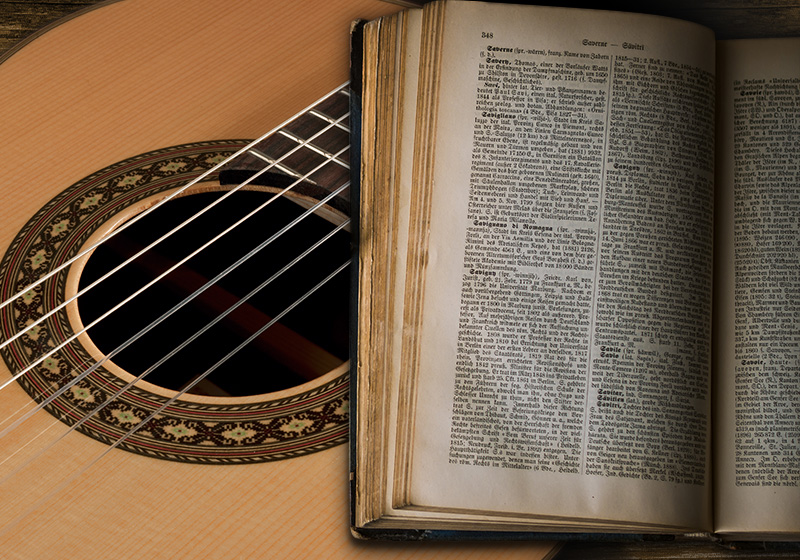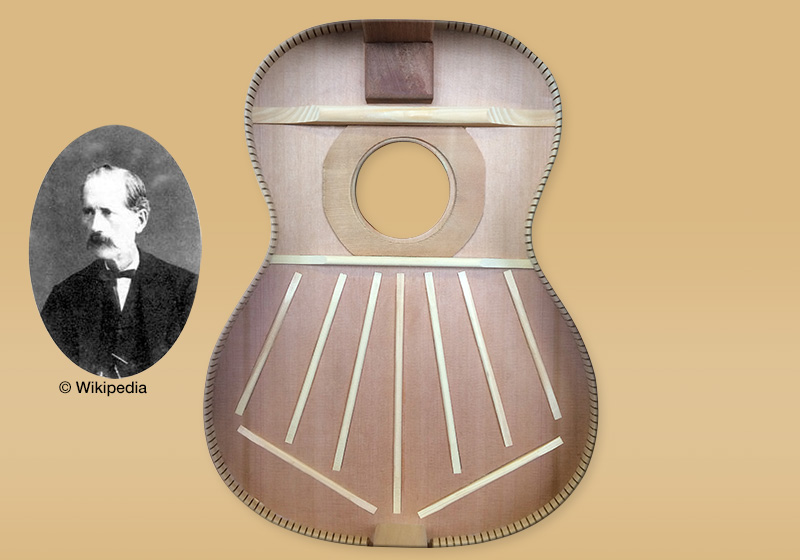History of the guitar
The guitar as we know it today is a rather modern instrument, having only existed in earnest since the 19th century, but its origins stretch far into our past.
The first stringed instrument was the hunting bow: a tendon stretched on a wooden stick. Based on cave paintings, archaeologists know that hunting bows became abundant around 10,000 BC, toward the end of the Paleolithic period. (Jahnel 1996, p. 14)
Over time, man combined the bow with a resonating body to amplify the sound of the string. Depending on the what was available locally, these bodies came in a variety of materials: Turtle shells, gourds, bamboo, and even coconuts could be used. (ibid.)
The next big evolution change to the guitar came in Spain, during the Romantic Period. For example, Antonio de Torres (1817 - 1892) developed the guitar as we know it today. First, Torres used a larger body and thinner wood than his predecessors. He also found a new method for a better sound: bracing the inside of the top with more resonant wood. Torres’ design included a five- to seven-strut system, arranged symmetrically. These design features remain intact in any classical concert guitar to this day.

The many ways of building a body
The first guitar bodies were simple objects that weren’t originally intended for use as an instrument. Around 2000 BC, people in both the Near and Far East were building instruments that consisted of a body, strings and a neck.
This concept is found in many variations throughout different cultures around the globe. Sometimes the neck is round, sometimes it’s flat. It can be long or short, and be made with or without frets. The top of the instrument can be made from wood, synthetics, or even animal skin.
It wasn’t until later that guitar builders began gluing wooden parts together to create cavernous bodies that would amplify the sound of the strings. These instruments were called lutes and they are often built with a "half-pear-shaped body whose shell consists of an uneven number of parts." (Jahnel 1996, p. 25) The term lute originates from the arabic word "Al'ud" or "El Oud", which means "the wood" or „wooden".

From Spain to Europe
During the Arab expansion of the early Middle Ages, the popularity of the lute spread throughout Egypt and into North Africa and Spain, but we cannot say definitively that the Arabian lute is the only direct ancestor of the modern guitar. Today’s guitar seems to have taken a great deal of influence from other stringed instruments as well, including the violin.
The Renaissance
During the Renaissance, the lute transformed drastically both in design and popularity all throughout Europe. Previously, the strings were created from plant products. But now, luthiers were using strands of animal intestine, tied around the head of the instrument in varying lengths in order to make different notes. Then, in the Baroque period, guitar music became more chordal, and only the guitarra received the required structural adjustments. The guitar lute then descended from the guitarra, featuring a novel design using single strings instead of chords. These instruments became increasingly popular in larger cities such as Vienna and Paris.
Antonio de Torres - Father of the modern guitar
The next big evolution change to the guitar came in Spain, during the Romantic Period. For example, Antonio de Torres (1817 - 1892) developed the guitar as we know it today. First, Torres used a larger body and thinner wood than his predecessors. He also found a new method for a better sound: bracing the inside of the top with more resonant wood. Torres’ design included a five- to seven-strut system, arranged symmetrically. These design features remain intact in any classical concert guitar to this day.
- Jahnel, Franz: The Guitar and its Construction. Technologie von Gitarre, Laute, Mandoline, Sister, Tanbur und Saite, Frankfurt a. M., 6th edition, 1996
- tabazar.de/history/, retrieved 22.05.2018
- Wikipedia: History of the Guitar
